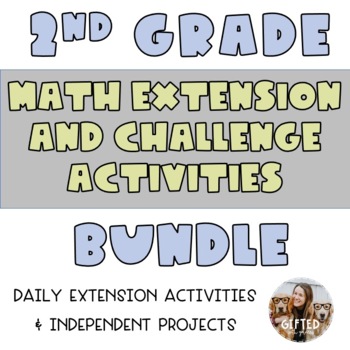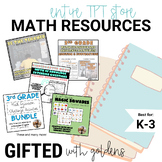ENTIRE YEAR 2nd Grade Math Extensions & Challenges: Advanced/Gifted BUNDLE
- Zip
What educators are saying
Products in this Bundle (5)
Also included in
- Are you a Gifted Teacher that works with many grade levels looking for a large supply of MATH resources?This bundle would be perfect for you! BEST PART? It will continue to grow and include ALL FUTURE Math Resources! **Make sure to purchase it NOW and receive all future notifications to re-downloadPrice $100.00Original Price $132.50Save $32.50
Description
2nd Grade Math: Advanced and Gifted Extensions BUNDLE
These resources supports deeper thinking and critical thinking for 2nd grade students in math of all subject areas.
The Bundle Includes:
- Addition and Subtraction
- Measurement
- Money
- Geometry
- Place Value
Some of my favorite ways to use it are for independent extensions, group collaboration work, small group projects, warm up challenges, end of the year extension projects and more! It is great for gifted students who need something MORE than the curriculum.
Interested in the 3rd Grade Bundle? Check it out here!
This bundled unit has been used by myself, my classroom teachers, and many teachers around the US. I have gotten great feedback, check it out!
" LOVE this resource! These packets provide SO MANY options for extensions and practice and the kids really enjoy them! I've used them predominantly with my students who need a little extra challenge and are my early finishers. The projects are fun and engaging and easy to implement, and the other worksheets are often game-like or puzzles that increase engagement. It's been a huge asset to me this year! " - Creative Engagement Corner
" This was exactly what I wanted to go with my math units. Great activities and center work!" - M C.
"So hard to find good extensions for my gifted kids, this is terrific! Thank you. " - Gwen M.
"These are great for challenging my high learners. I really saw who could think critically when I started using these with my higher math students." - Kristin M.
Below are the standards addressed in this bundle:
CCSS2.MD.A.1
Measure the length of an object by selecting and using appropriate tools such as rulers, yardsticks, meter sticks, and measuring tapes.
CCSS2.MD.A.2
Measure the length of an object twice, using length units of different lengths for the two measurements; describe how the two measurements relate to the size of the unit chosen.
CCSS2.MD.A.3
Estimate lengths using units of inches, feet, centimeters, and meters.
CCSS2.MD.A.4
Measure to determine how much longer one object is than another, expressing the length difference in terms of a standard length unit.
CCSS2.MD.B.5
Use addition and subtraction within 100 to solve word problems involving lengths that are given in the same units, e.g., by using drawings (such as drawings of rulers) and equations with a symbol for the unknown number to represent the problem.
CCSS2.MD.B.6
Represent whole numbers as lengths from 0 on a number line diagram with equally spaced points corresponding to the numbers 0, 1, 2,..., and represent whole-number sums and differences within 100 on a number line diagram.
CCSS2.MD.C.8
Solve word problems involving dollar bills, quarters, dimes, nickels, and pennies, using $ and ¢ symbols appropriately. Example: If you have 2 dimes and 3 pennies, how many cents do you have?
CCSS2.MD.D.9
Generate measurement data by measuring lengths of several objects to the nearest whole unit, or by making repeated measurements of the same object. Show the measurements by making a line plot, where the horizontal scale is marked off in whole-number units.
CCSS2.NBT.A.1
Understand that the three digits of a three-digit number represent amounts of hundreds, tens, and ones; e.g., 706 equals 7 hundreds, 0 tens, and 6 ones. Understand the following as special cases
CCSS2.NBT.A.1a
100 can be thought of as a bundle of ten tens - called a “hundred.”
CCSS2.NBT.A.1b
The numbers 100, 200, 300, 400, 500, 600, 700, 800, 900 refer to one, two, three, four, five, six, seven, eight, or nine hundreds (and 0 tens and 0 ones).
CCSS2.NBT.A.2
Count within 1000; skip-count by 5s, 10s, and 100s.
CCSS2.NBT.A.3
Read and write numbers to 1000 using base-ten numerals, number names, and expanded form.
CCSS2.NBT.A.4
Compare two three-digit numbers based on meanings of the hundreds, tens, and ones digits, using >, =, and < symbols to record the results of comparisons.
CCSS2.NBT.B.5
Fluently add and subtract within 100 using strategies based on place value, properties of operations, and/or the relationship between addition and subtraction.
CCSS2.NBT.B.6
Add up to four two-digit numbers using strategies based on place value and properties of operations.
CCSS2.NBT.B.7
Add and subtract within 1000, using concrete models or drawings and strategies based on place value, properties of operations, and/or the relationship between addition and subtraction; relate the strategy to a written method. Understand that in adding or subtracting three-digit numbers, one adds or subtracts hundreds and hundreds, tens and tens, ones and ones; and sometimes it is necessary to compose or decompose tens or hundreds.
CCSS2.NBT.B.8
Mentally add 10 or 100 to a given number 100–900, and mentally subtract 10 or 100 from a given number 100–900.
CCSS2.NBT.B.9
Explain why addition and subtraction strategies work, using place value and the properties of operations.
CCSS3.NBT.A.2
Fluently add and subtract within 1000 using strategies and algorithms based on place value, properties of operations, and/or the relationship between addition and subtraction.
CCSS2.OA.A.1
Use addition and subtraction within 100 to solve one- and two-step word problems involving situations of adding to, taking from, putting together, taking apart, and comparing, with unknowns in all positions, e.g., by using drawings and equations with a symbol for the unknown number to represent the problem.
CCSS2.OA.B.2
Fluently add and subtract within 20 using mental strategies. By end of Grade 2, know from memory all sums of two one-digit numbers.
CCSS2.OA.C.4
Use addition to find the total number of objects arranged in rectangular arrays with up to 5 rows and up to 5 columns; write an equation to express the total as a sum of equal addends.
CCSS2.G.A.1
Recognize and draw shapes having specified attributes, such as a given number of angles or a given number of equal faces. Identify triangles, quadrilaterals, pentagons, hexagons, and cubes.
CCSS2.G.A.2
Partition a rectangle into rows and columns of same-size squares and count to find the total number of them.



